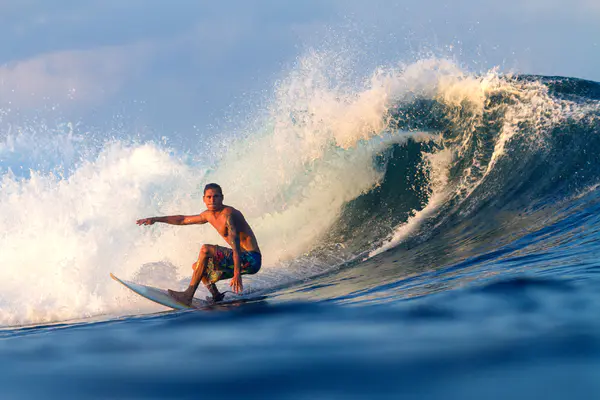Surfing is a thrilling sport. It requires understanding various oceanic conditions. One key element is the swell. Swell is vital for surfers. It determines the quality of waves.
Understanding Swell
Swell refers to a series of ocean waves. These waves are generated by distant weather systems. The energy from these systems travels across the ocean. When this energy reaches shallow water, it creates surfable waves.
Formation of Swell
Swell formation starts with wind. Strong winds blow across the ocean’s surface. This action transfers energy to the water. Over time, this energy forms waves. The distance the wind blows over the water is called fetch. Longer fetch means larger swells.
Types of Swells
There are two main types of swells: ground swells and wind swells.
- Ground Swells: These are generated by distant storms. They travel long distances. Ground swells produce larger, more powerful waves. Surfers prefer ground swells for their consistent quality.
- Wind Swells: These are created by local winds. They are usually smaller and less powerful. Wind swells can be choppy and less predictable.
Swell Period
The swell period is the time between wave crests. It is measured in seconds. A longer swell period indicates a more powerful swell. Swell periods can range from 5 to 20 seconds. Surfers look for swells with periods of 10 seconds or more.
Swell Direction
Swell direction is the angle at which waves approach the shore. This can affect wave quality. For example, a swell hitting the shore at a perpendicular angle creates better waves. Surfers need to understand local geography. This helps them predict wave quality based on swell direction.
Reading a Swell Forecast
Surf forecasts provide essential information. They include swell height, period, and direction. Surfers use this data to plan sessions. Online surf forecast websites and apps are popular. They offer detailed and updated information.
Impact of Swell on Surfing Conditions
Swell height affects wave size. Bigger swells produce larger waves. The period influences wave power. Longer periods mean stronger waves. Direction determines wave shape and rideability.
Swell and Safety
Understanding swell is crucial for safety. Large swells can create dangerous conditions. Rip currents and strong waves pose risks. Surfers should always check forecasts. They must be aware of their skill level and the conditions.
Global Swell Patterns
Different regions experience varying swell patterns. For instance, the North Shore of Hawaii is famous for its winter swells. California sees consistent swells year-round. Understanding these patterns helps surfers travel to the best spots.
Detailed Breakdown of Swell Dynamics
Now, let’s delve deeper into the dynamics of swell in surfing. This section will cover the following aspects:
- How wind generates swells
- The role of the ocean floor
- Seasonal variations in swell
- Regional differences in swell patterns
How Wind Generates Swells
Wind plays a crucial role in swell formation. When wind blows over the ocean, it transfers energy to the water. This energy forms waves. The size and strength of these waves depend on several factors:
- Wind Speed: Faster winds generate more energy. This creates larger waves.
- Wind Duration: The longer the wind blows, the more energy is transferred.
- Fetch: The distance over which the wind blows is critical. Longer fetches allow waves to grow larger.
As waves move away from their origin, they become more organized. This process is called wave dispersion. The waves separate based on their speed and wavelength. This results in well-defined swell lines.
See Also: Which Beach Has Water Sports in Goa?
The Role of the Ocean Floor
The ocean floor significantly impacts swell behavior. When swell reaches shallow water, it interacts with the seabed. This interaction shapes the waves. Key factors include:
- Bathymetry: The study of underwater depth. Different underwater features, like reefs and sandbars, affect wave formation.
- Wave Refraction: As waves approach the shore, they bend. This bending is due to changes in water depth. It can focus wave energy on specific spots, creating better surfing conditions.
- Wave Reflection: Waves can bounce off underwater structures. This can create complex wave patterns.
Seasonal Variations in Swell
Swell patterns vary with seasons. Understanding these variations helps surfers plan their activities. Here’s a look at how seasons influence swell:
- Winter: In the Northern Hemisphere, winter brings stronger swells. This is due to intense storm systems. The North Pacific and North Atlantic generate powerful swells.
- Summer: Summer swells are generally smaller. However, tropical storms can produce significant swells. In the Southern Hemisphere, winter occurs during the Northern Hemisphere’s summer. This brings large swells to regions like Australia and South Africa.
- Spring and Fall: These transitional seasons can offer a mix of conditions. They may not have the extremes of winter or summer but can provide consistent swell.
Regional Differences in Swell Patterns
Different regions have unique swell characteristics. Here are a few notable examples:
- Hawaii: Known for its powerful winter swells. The North Shore of Oahu is a prime spot for big wave surfing.
- California: Offers consistent swells year-round. Winter brings larger waves from the North Pacific. Summer sees smaller but rideable waves from the Southern Hemisphere.
- Australia: Experiences diverse swell patterns. The east coast sees consistent swells, while the west coast gets large winter swells.
- Indonesia: Famous for its consistent swells and perfect waves. The Indian Ocean generates reliable swells throughout the year.
Conclusion
Understanding the dynamics of swell is essential for surfers. Wind, the ocean floor, and seasonal variations all play a role. By studying these factors, surfers can predict wave conditions more accurately. This knowledge not only enhances their surfing experience but also ensures safety. Mastery of swell dynamics is a crucial skill for any serious surfer.

